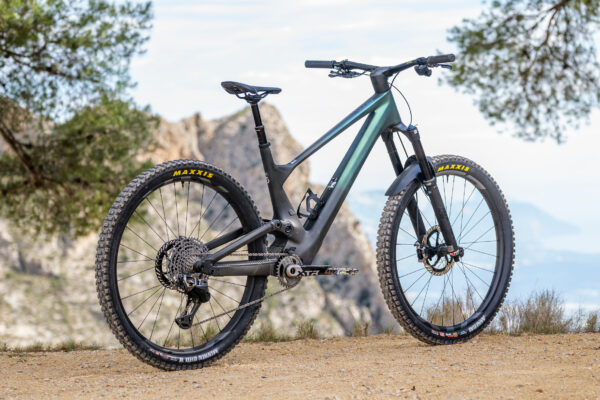Nearly 10 years in development, Shimano’s flagship XTR Di2 M9200 groupset is innovative and unique, and addresses almost all the problems I had with the old lineup
Shimano has a new version of its premium XTR groupset, it features – for the first time ever – completely wireless shifting, as well as a new range of wheels and brakes.
Called XTR Di2 M9200, it’s been a long time coming, after first launching electronic shifting nearly a decade ago. Now Shimano has an electronic drivetrain to rival that of SRAM AXS T-Type Transmisson, with the new XTR focussed on fast shifting, and capable of multiple gear changes or continuous shifts up and down the block.
There are also a host of other new parts and features to run through, from wheels to brakes. Check out my review of Shimano XTR M9200 Di2 or keep reading for a full rundown on the new drivetrain options, wheels, and brakes, including prices.

Shimano’s new XTR groupset includes the wireless drivetrain, and a revised brakeset
Shimano XTR need to know
- New groupset includes Di2 wireless shifting, new wheels and brakes
- XTR Di2 M9200 goes fully wireless, and there’s an option for e-bikes too
- Latest brakes get better modulation, more power and no more wandering bite
- Wheels are 29er only, with trail and XC options
- Improved shifting means it joins the best mountain bike groupsets of 2025

XTR is now electronic and wireless for the first time
XTR goes wireless (and wired, wireless too!)
The most exciting development is that XTR Di2 is now fully wireless, meaning you can bolt it to any bike going – from and XC race machine to a super enduro bike, and everything in between. Electronic shifting isn’t new to Shimano, it first launched the setup in 2016, but it relied on being wired into an e-bike battery to work.
The new setup features an integrated battery, hidden inside the mech’s parallelogram, where it can’t be smacked off by a wayward rock. As such the mech looks much fatter than anything I’ve seen before, and it’s also much sleeker and more slippery looking. The idea is to make it better at bouncing off obstacles that would otherwise leave you stranded with your mech snapped off at the hanger.
Which brings us to the next new feature from XTR Di2, its get out of jail card. Just like SRAM’s AXS Transmission, XTR can move out of the way when it senses an impact. And unlike AXS, it can move back into place again afterwards, meaning you can keep on pedalling without spoiling your ride… or your race.

XTR Di2 sits higher off the groud than plenty of rivals, meaning it’s less likely to take a hit
Shimano hasn’t forgotten about e-bikes just yet though, there’s also a new wired version of XTR that plugs into the latest Shimano EP801 battery. It works in exactly the same way, but obviously negates the need for a battery in the rear mech. Both new setups are 12 speed, and both use the Shimano’s Hyperglide+ shifting technology. Oh and there’s also still an 11 speed Linkglide version for e-bike use.
Shimano says its new cassette – featuring titanium, alloy and steel sprockets – is smoother and more durable in this new version when shifting under load. In fact Shimano encourages you to do just that, precisely because the system waits for the chain to be on the shift ramps before moving the derailleur, which should stop it getting in a tangle.
XTR uses a microspline interface and you can get it in two options: 9-45T and 10-51T. This means we’re seeing a 9T Shimano high gear for the first time on a mountain bike, something the brand introduced a few years back on gravel.

New crankset comes in multiple length arms, but doesn’t go short enough for e-bikes in the era of 55mm cranks
Shimano’s usually pretty restrained when it comes to graphics, but new XTR cranks are positively lairy. There are two options: one for trial enduro riding, with a stronger spindle, 176mm Q-factor, and five length options from 160-175; and a lighter one for XC with a 168mm Q-Factor, and crank options of 165, 170, and 175mm.
Both crank arms get the new Hollowtech II construction and are made from alloy. They also use the standard 55mm chainline too, which tells you there’s no longer an option to run a double chainring up front.

Mount the new shifter to your bars via i-spec, or stand alone band
Naturally there’s also a new shifter to go with XTR and it’s really very good in feel and use. The paddles are programmable so you can choose which button shifts up and which down, and they can swivel around to get the best placement for your thumb. I also like the third button, which is programmable to operate things like bike computers, Autoshift, or perhaps even a POV camera.
Shimano XTR Di2 drivetrain pricing
- Crankset 249.99
- Chainring 129.99
- Derrailleur 549.99
- Shifter switch 184.99
- Cassette 399.99
- Battery 39.99
- Charger 29.99
- Chain 54.99

Shimano has sorted out its wandering bite point issue of old
Brakes £249.00 (four pot), £229.99 (two pot)
Shimano has shifted the XTR pivot point and lever body closer to the bar, changing the trajectory of it to a more natural arc. This means it doesn’t rotate inwards, but comes straight back to the bar. I’ve written a full review of the new Shimano XTR M9220 brake, go check it out for a full rundown.
This change in position and lever feel is possible thanks to a new pull stroke action in the lever body. Shimano is now also using a low-viscosity mineral oil inside that it reckons works better in colder weather, and means lighter seals are needed.
The caliper is a one-piece design, it now uses bigger pads with more contact and they’re held in place more securely to stop any rattle. It’s a four pot or two pot brake, depending on what your intentions are.
The take home then is that Shimano has cured the dreaded wandering bite point, and the rattle that came from some pads. It’s also increased the power and improved modulation.

This trail or enduro wheel gets 28 spokes and a 30mm rim internal width
Wheels £1,699.98
XTR wheels come in two guises, an enduro or trial version and one for XC. There’s no information yet on the weights, but we do know they’re both 29in only, with rims made from carbon and a new hub design.
The enduro wheels get 30mm internal width, stainless-steel spokes, 28 spokes, microspline driver body and a centrelock brake mount.
The XC wheels have a narrower 29.6mm internal width, get 24 titanium spokes, and the same microspline and centrelock standards.




